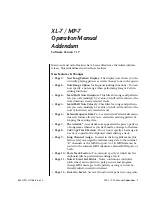
Lake Shore Model 370 AC Resistance Bridge User’s Manual
Resistance Measurement Calibration (Continued)
The
CALVIN?
query returns only the voltage part of the equation so that current and voltage contributions can be
separated for calibration. The voltage represented is the voltage at the input terminals (V+, V–) of the instrument.
The equation for CALVIN is as follows:
Calibrated Voltage (CALVIN) = [(A/D Voltage / Ideal Gain) – CALZ(V)) × CALG(V)]
The fundamental relationship between current, voltage and resistance is straightforward but the interaction of the
calibration coefficients should be noted. The measurement input allows calibration of 22 individual current gains and
12 voltage ranges with zero offset and gain. (Calibration can be performed on voltage ranges and current settings shown
in Table 1-1 but not all combinations can be selected during operation.) This results in 46 calibration coefficients for the
input alone. This approach was chosen because calibrating each possible combination of voltage range and current would
require 528 coefficients. Even the chosen method has difficulties. Some of the voltages and currents are so small that
they cannot be measured with conventional calibration equipment. After the basic calibration technique is described, a
method is described in Paragraph 8.12.2.6 for using the Model 370 and known resistances to perform a calibration.
8.12.2.1
Voltage Measurement Zero Offset
To calibrate voltage zero offset perform the following sequence of operations. Voltage zero offset must be calibrated
before voltage gain.
1. Create an input short by connecting all four voltage and current measurement leads together (V+, V–, I+, I–). Lead
wires should be kept as short as possible and soldered together. Spring tension lead clips will not make appropriate
connections.
2. Attach the input short to the instrument and allow it to warm up for 1 hour.
3. Select the highest voltage range (632 mV) and the highest resistance (lowest current) range available for that voltage
range (63.2 M
Ω
/10 nA for the highest range).
4. Use the CALZ? and CALG? queries to read and record the coefficients for the selected voltage range. (A safety step
to revert to the original calibration if necessary)
5. Set the CALZ and CALG coefficients for the selected Voltage range to default (0 and 1). (The current source CALG
coefficient does not have to be set to default (1) for this operation.)
6. Read the short circuit voltage for the range using the CALVIN? query. Sufficient settling time and filtering must be
used to obtain a stable reading. Refer to Paragraph 8.12.2.6 for practical filter time constants. The CALVIN reading
is not filtered with the instrument filter feature. The voltage read should be 0 volts,
±0.02
% of the voltage range.
7. Send the value read with the CALVIN? query as the CALZ coefficient. Example for the highest voltage range:
CALZ 2, 12, +12.3456E-6
8. Send the CALSAVE command and wait 10 seconds for the calibration to be saved in non-volatile memory.
(Alternately, this step can be done after all ranges are calibrated.)
9. Select the next lowest voltage range and repeat from Step 3 until all ranges are calibrated. Refer to Paragraph
8.12.2.6 for voltage range numbers.
NOTE:
Lower voltage ranges (especially below 200
μ
V) require long filter time constants to obtain a stable zero
offset measurement. Zero offsets for ranges below the highest range can be calculated instead of being
measured. To calculate zero offsets of lower ranges, scale the last measured offset by the difference in ideal
gain on the consecutive ranges. For example divide by 3.16228, 10, 31.6228, 100 and so on.
8.12.2.2
Voltage Measurement Gain
To calibrate voltage gain, perform the following sequence of operations. Voltage Gain must be calibrated after voltage
zero offset because the voltage zero offset procedure sets the gain coefficient to default.
1. Attach
a
20
Ω
resistor to the input of the instrument with short leads.
2. Allow the instrument to warm up for 1 hour.
3. Select the highest voltage range (632 mV) and the 20
Ω
resistance range.
4. Use the CALG? query to read and verify that the gain coefficient for the selected voltage range has been set to
default during zero calibration.
Service
8-17
Содержание 370
Страница 22: ...Lake Shore Model 370 AC Resistance Bridge User s Manual 1 12 Introduction This Page Intentionally Left Blank ...
Страница 60: ...Lake Shore Model 370 AC Resistance Bridge User s Manual 3 16 Installation This Page Intentionally Left Blank ...
Страница 106: ...Lake Shore Model 370 AC Resistance Bridge User s Manual 5 12 Advanced Operation This Page Intentionally Left Blank ...
















































